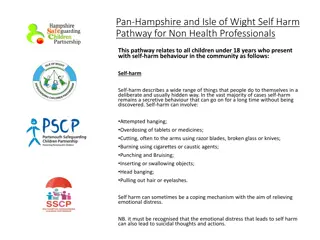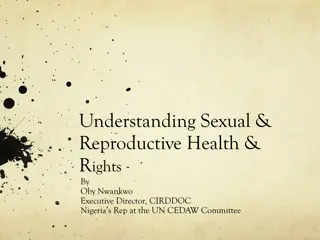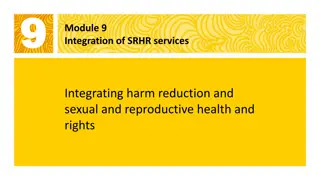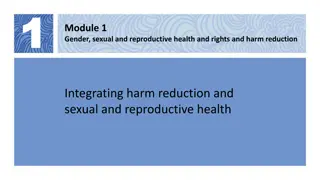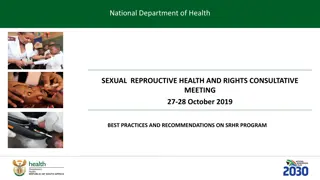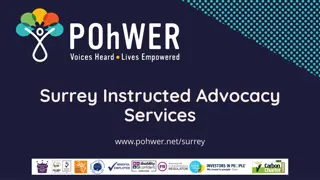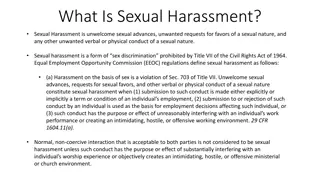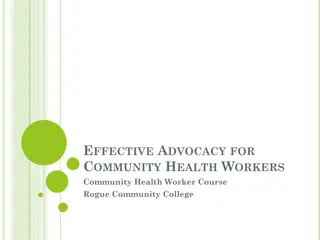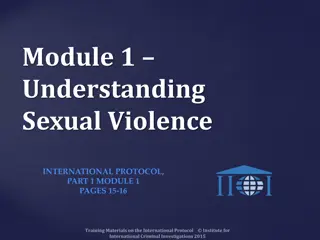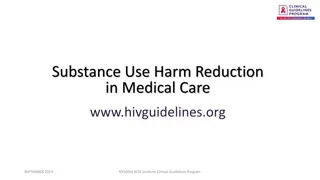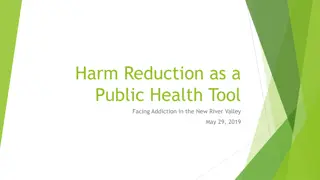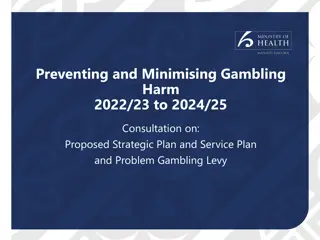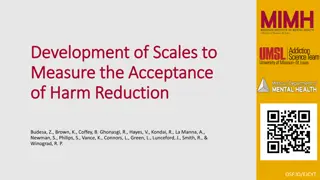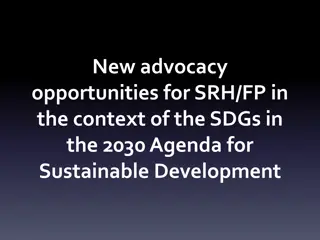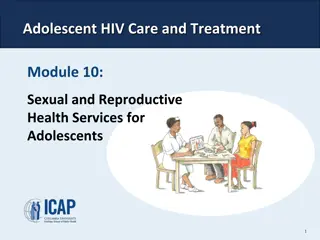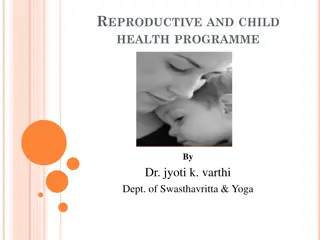Integrating Harm Reduction and Sexual & Reproductive Health Advocacy
This module focuses on advocating for the sexual and reproductive health rights of women and gender non-conforming individuals who use drugs. It covers identifying barriers, setting advocacy goals, understanding advocacy elements, and implementing advocacy strategies to create a more enabling environment and empower communities. The advocacy steps outlined include defining issues, engaging with decision-makers, and evaluating outcomes. Participants also work on identifying legal and administrative barriers related to various SRHR topics. The module emphasizes utilizing media work and lobbying as key advocacy strategies.
Download Presentation

Please find below an Image/Link to download the presentation.
The content on the website is provided AS IS for your information and personal use only. It may not be sold, licensed, or shared on other websites without obtaining consent from the author.If you encounter any issues during the download, it is possible that the publisher has removed the file from their server.
You are allowed to download the files provided on this website for personal or commercial use, subject to the condition that they are used lawfully. All files are the property of their respective owners.
The content on the website is provided AS IS for your information and personal use only. It may not be sold, licensed, or shared on other websites without obtaining consent from the author.
E N D
Presentation Transcript
10 10 Module 10 Advocacy Integrating harm reduction and sexual and reproductive health and rights
Module 10 Advocacy LEARNING OBJECTIVES 2 hours To identify gaps and barriers to accessing SRHR for women and gender non-conforming people who use drugs in the country To prioritise key actions and targets for advocacy
Module 10 Advocacy WHAT IS ADVOCACY? 10 minutes Working in 3 groups Develop a concise explanation with these words: enabling environment legislation decision-makers rights criminalisation inequity discrimination changes influence policy
Module 10 Advocacy ELEMENTS OF ADVOCACY Advocacy can contribute to creating an enabling environment and empowering communities. It includes strategies to influence decision-makers to bring solutions to identified problems. It is a process to adress inequity, to denounce legislation, policies, administrative regulations, practices and crimilasitation of drug use, which undermine the rights of women and gender non-conforming people who use drugs. It aims to bring about long-lasting changes in policy, procedures and practices to promote SRHR of women and gender non-conforming people who use drugs to reduce violence, discrimination and stigma. Women and gender non-conforming people who use drugs should be enabled to contribute to and lead advocacy efforts.
Module 10 Advocacy 10 ADVOCACY STEPS 1. Define your issue 2. Set goals and objectives 3. Identify target audience, decision-makers and influencers 4. Engage in partnership and identify allies 5. Assess resources 6. Plan advocacy actions 7. Create advocacy communication/messages 8. Develop monitoring and evaluation plan 9. Take action! 10.Evaluate
Module 10 Advocacy IDENTIFY YOUR BARRIERS? 25 minutes Working in 3 groups, identify: Legal barriers Administrative procedures barriers Topics Abortion Contraception Cervical cancer Gender-based violence HIV/STI prevention, testing and treatment Perinatal and newborn care, including NOW Sexuality and menstrual hygiene
Module 10 Advocacy ADVOCACY STRATEGIES AND ACTIONS Media work: increases the visibility of your cause, sensitises public opinion to your cause, and presents the arguments in favour of change. Actions include: press release, press dossier, open letter in the newspaper, newspaper insert or article, web banner, TV/radio spot, training journalists. Lobbying: this involves direct contact with your target decision- makers to explain your intentions, the changes you seek, and to convince them to act. Actions include: meetings policymakers, participating in ministerial working groups, organising field visits for decision-makers, participating in public consultations, proposing parliamentary questions. Public campaigning: this covers a variety of actions that aim to influence decision-makers indirectly. Public campaigning can sensitise a large number of people to your cause and gather together a sizeable support base. Actions include: petitions, demonstrations, letters to Members of Parliament, e-actions through social media, remembrance days Litigation: take legal action to defend the rights of the people concerned
Module 10 Advocacy ADVOCACY TARGETS AND ALLIES There are two types of targets: Primary target audiences are the decision-makers who have the authority to bring about the desired policy change. Secondary target audiences are people who have access to and can influence the primary audience. Example: Heads of state, ministers, political advisors, technical advisors, parliamentarians, representatives of local organisations, representatives of religious organisations, representatives of international agencies and/or financial and technical partners, local health authorities. Allies Although not part of your advocacy team, these people support your work and your objectives. Alliances/partnerships may be built with a diverse range of actors, such as civil society groups, other NGOs, experts/ academics
Module 10 Advocacy TAKE ACTION! 40 minutes Working in 3 groups From the gaps/barriers identified, prioritise one barrier you want to address through advocacy Criteria: importance and/or urgency, achievability, allies already identified to support the action 15 minutes REPORT BACK
Module 10 Advocacy ADVOCACY LED BY WOMEN AND GENDER NON- CONFORMING PEOPLE WHO USE DRUGS Groups or networks of women and gender non- conforming people who use drugs should participate in and lead advocacy efforts, including those directed at the wider public to reduce discrimination. Support to establish and develop networks of women and gender non-conforming people is critical
Module 10 Advocacy EXAMPLE: The objective: was to provide evidences and testimonies about the gender-based violence experienced by women who use drugs and to propose changes in the policy and programmes to prevent and stop violence agains women who use drugs. The targets were the general population, policymakers, law enforcement and international partners. Different actions were taken in 12 countries worldwide and were all published in a final report on the WHRIN website. The actions held were: social media campaigns, meetings with women who use drugs to collect testimonies, debates and demands to politicians, talkshows on radio, collaborating with local artists, making films, training on rights. Visit the website: https://whrin.site/campaign
Module 10 Advocacy EXAMPLE: Federal Capital Abuja, Nigeria The objective of the advocacy was to provide friendly SRHR services for young women who use drugs. The target was the Primary Health Care Development Board These different actions were taken to sensitise the Primary Health Care Development Board about the specific needs of young women who use drugs: Visiting primary healthcare Discussion between the Executive Director of YouthRise Nigeria, and the Gender Programme Advisor and Director of SRHR service at the Primary Health Care Development Board Training primary healthcare workers on delivering friendly SRHR services for young women who use drugs The achievements were a change in the behaviour of primary healthcare workers, and the increase of service uptake within primary healthcare facilities by young women who use drugs due to decreased fears of been stigmatised and discriminated against.
Module 10 Advocacy EXAMPLE: Nigeria The objective was to advocate for harm reduction services, which only a small percentage of people who use drugs received, including specific services for women who use drugs. The targets were the implementing partners and government agencies. The action was to develop a diary with key advocacy messages every month. The achievement was to increase visibility of the drug user network and the needs of women who use drugs.







